
Octagon View
The panels, with the working engine beyond
Of things to do on a afternoon going to a place well known for excrement may not be high on the list. When that place is part of the mass Victorian infrastructure of London things are different though. So Heather, Gemma, and I went out to find Crossness Pumping Station.
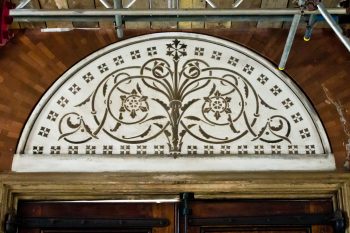
Fancy Scrollwork
Above the doorway
Crossness itself is somewhat in the middle of nowhere (and in the middle of a still working sewage treatment works) so its a good job that on open days a special coach is laid on from the nearest station to the site. On arrival is the sort of slightly disorganised homely welcome which makes it clear this really is a volunteer enthusiast run scheme. We started off our little tour round in one of the adjunct buildings, a fitting shop which is still evidently a useful workshop today. While it has that welcoming workshop smell and a couple of small engines it is just that, a workshop not a display and hence really doesn’t offer too much to look at.
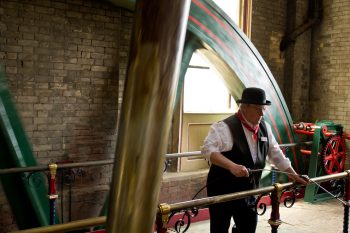
Oiler
Keeping the smooth running of the fly wheel. Not the hand barring engine in the background
After a brief look across the field covering the reservoir (itself now covered in a PV farm) we quickly made our way to the main building. First encountered is a vast space which was once the boiler house of the station (the space though doesn’t give a true sense of the history due to the floor at some point having been raised. Once it would have been possible to look down on the boilers from the now level entrances). Today this space is filled with an exhibition describing the pumping station and the wider system of sewers it connected to. It also holds a far too small and slightly chaotic cafe, which we delayed visiting due to how busy it was becoming.
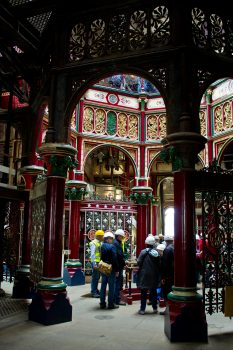
Inside The "Cathedral"
Coming into the cathedral like space
Collecting a hard hat each we made our way into the main building, with its four great steam driven pumps. Having seen quite a number of photographs of Crossness perhaps the most surprising thing is how “unfinished” most of it is. Whilst one pump is alive and running and the central crossing point, a semi-panelled octagon, is bright a good half of the building actually remains in its abandoned state. This is no aspersion on those who have restored that one corner and are obviously hard at work on another. The attention to detail and evident love show what a time consuming task it must be. It is simply that it was an unexpected contrast—and not necessarily a bad one. Just as one panel of that glorious central octagon has been left in its unrestored state so a half of the building silently speaks to the ravishes of time which have been beaten back.
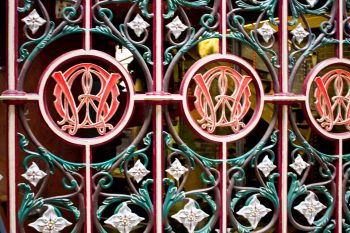
Logo
The monogram of the MWB worked into the iron
And how wonderfully glorious the part which has been restored is. That central crossing point between the four corner pumps how unnecessarily ornate but simply beautiful the place is. It is difficult to imagine now a functional building such as this being given such intricate decoration, particularly as it wasn’t really on public display (unlike, say, the great underground architecture of a similar era) but hidden in such an otherwise unattractive place. Everywhere red and green painted wrought iron and gleaming steel brighten the most dirty of engineering endeavours. This is never more so than on the gloriously restored pump itself. It called to us, a rhythmic hissing a thump as the great beam above rose and fell. The great flywheel was almost hypnotic in its spinning, the great drive shafts (held in place but no longer attached to the actual pumps) massive arms reaching into the Earth.
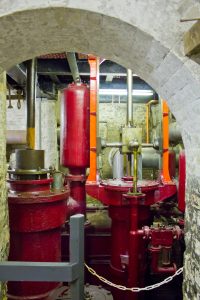
Air and Water Pumps
The air pump drew exhaust steam into a condensor, where it was cooled by water from an external pool. These pumps were driven by the counter-beam
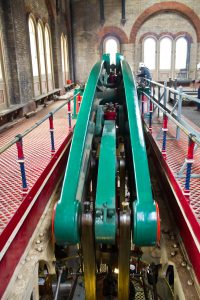
Along The Beam
Looking along the length of the main beam
Going down into the first of two basement spaces we descended a spirally stair into the ground. Walking round the tight space it was possible to see there auxillary air and water pumps, driven from a counter beam of the engine above. Back up the staircase and down to the second basement found the ends of the main connecting rods, the pumps which once worked so hard. Having been down we want up, climbing the suitably ornate stairs to the beam floor. There the great beam of the engine emerges, its huge bulk slowly oscillating up and down in the, at this level, vast feeling space.
We’d enjoyed our look around but, apart from an echoing and abandoned later additional building, and the original front entrance, that was about all there really is to see. We made our way out the space, with its ornate panels and details which give it, if not the same glory as a cathedral the impression that if this isn’t a religious place it is some sort of church to the great beasts of engines within it.
The cafe was still busy but we managed to squeeze in a table for a surprisingly wide selection of equipment before paying a visit to the shop (little more than a couple of tables piled with magnets and the like) and heading away on that special coach. Well worth a short but fascinating visit, if only to take many photos.
Comments and Pings